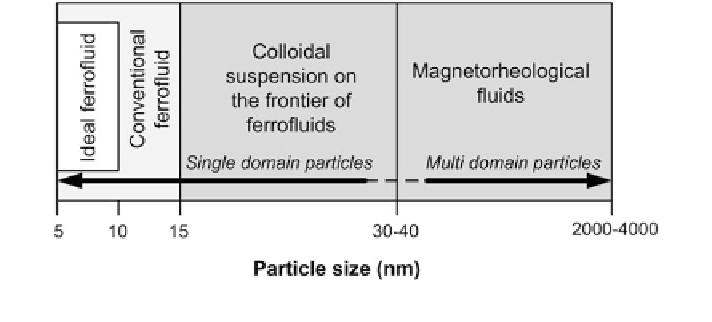Environmental Engineering Reference
In-Depth Information
Fig. 5.4 The classication of magnetic
fl
uids according to Lopez et al. [
16
]
eld will be the reduced in
fl
uence of the magnetically induced yield stress, by
changing the solid MR
uid into its liquid suspension form.
Note that there is no clear de
fl
nition of the transition from a ferro
fl
uid to an
magnetorheological
uid. Lopez et al. [
16
] presented an example for such a tran-
sition, as shown in Fig.
5.4
. They have de
fl
uid as a colloidal
suspension of nanoparticles of ferro- or ferrimagnetic materials dispersed in a liquid
carrier which do not settle, despite the potential long-term exposure to the applied
(gravitational or magnetic)
ned the ideal ferro
fl
-
uids, dispersed particles should be smaller than approximately 10 nm and coated
with a molecular layer of surfactant to prevent the van der Waals attractive forces.
Under these conditions, Brownian motion dominates over the forces of interaction.
The real ferro
eld. As denoted by Lopez et al. [
16
], in ideal ferro
fl
dipole energy of the interaction
between them overcomes Brownian motion and causes clustering under the applied
magnetic
fl
uids are polydispersed. The dipole
-
eld. The latter increases the viscosity and can also lead to yield stress.
Genc and Derin [
17
] also de
ned ideal ferro
fl
uids as colloidal suspensions of
ultra
uids,
the size would be in the range from 5 to 15 nm. For a particle size between 15 and
40 nm they considered the magnetic
ne (5
-
10 nm) single-domain magnetic nanoparticles and for real ferro
fl
fl
uid to be a ferro
fl
uid. Above this limit, the
fl
uid would exhibit the characteristics of an MR
fl
uid.
5.2.1 Rheology of Ferro
fl
uids
Since the
uids have neglected the interaction
between solid particles, according to Odenbach [
18
], these theories can only be
used for quantitative predictions of the behaviour of highly diluted
rst theories on the rheology of ferro
fl
uids. This is
especially because experimental results have shown that a strong in
fl
fl
uence on
viscosity can be induced by a magnetic
eld, not only in magnetorheological
fl
uids,
but also in ferro
fl
uids with suf
cient particle
particle interaction.
-

Search WWH ::

Custom Search